
Foliage: A Closer Look at the Most Common Leaf Shapes
Knowing how to recognise them to better incorporate them into the garden
Contents
The plant world offers us an incredible variety of leaf shapes, making each tree, bush, grass or small perennial unique and recognisable.
Initially classified according to their position on the stem as opposite or alternate, leaves display lamina that may be ovate, round or more or less divided, palmate, sometimes even perfectly cylindrical as in water lilies for example. Just like flower shapes, the botanical dictionary dedicates a rich, highly specific vocabulary to them, which I invite you to discover in this article entirely devoted to them!

Creating your herbarium means entering the wonderful world of leaves, all so different!
Recognising a leaf
A plant species is often recognised by the shape of its foliage, which is usually what catches our eye. However, the leaves themselves have a far more complex anatomical structure.
In this article, we will focus solely on the shape of the lamina—the dominant, flat, and broad part—though leaves actually possess other characteristics unique to each species that help refine identification or distinguish between species or varieties, including:
- Whether they are single (a single lamina, like a lilac leaf) or compound (composed of multiple leaflets, pinnate or sometimes bipinnate, like a mimosa leaf): this is the first key identifier in botany.
- Their arrangement on the stem and relative to one another, opposite (facing each other, two leaves at each node) or alternate (only one leaf at each node)—to name just the two most common arrangements. This is known as phyllotaxy and serves as the second key identifier.
- How they attach to the stem, which helps refine recognition: often petiolate, but also sheathing, perfoliate, sessile (without a petiole), and many others…
- The shape of their margins: edges or borders can be entire, dentate, incised, undulate, crenate, thorny, sinuate, ciliate, etc.
- Their nervature, meaning the pattern and positioning of their veins (botany uses around fifteen surprising terms like campylodromous, parallelodromous for parallel veins, palinactinodromous, etc.).
- Their colour, ranging from green to bronze and blue, through purple, red, or black.
- As well as their size, petiole length, texture—glabrous or downy, etc.
The shape itself—our focus here—generally provides clues about a plant’s species. It is a key marker in plant morphology and species classification. Often, it falls somewhere between two forms, depending on the species or the leaf’s stage of development (basal or upper leaves). We’ll explore these in detail below.
The ovate leaves
Just in terms of leaf morphology, there are around forty shapes, each with its own descriptive term, which goes to show the diversity of the plant world! Among these, many are similar, with numerous subtle nuances.
Without listing them all here, I’ve grouped leaf shapes into broad “families” and selected the most classic or recognisable ones for clarity in this vast foliar universe. To begin, here are the most common ovate leaves, which include:
Ovate leaves
Leaves shaped like an oval, wider in the middle. Many leaves can simply be described as ovate.
Examples: holly (with dentate margins), Magnolia soulangeana, Malus sp. (apple trees), Ficus elastica.
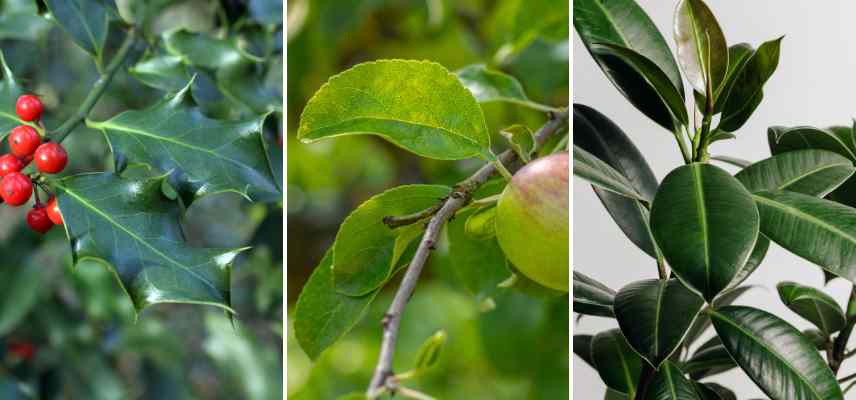
Holly, apple tree, and Ficus elastica
Elliptical leaves
An elegant variation of ovate leaves, gracefully tapered. These elliptical-shaped leaves, wider in the middle and tapering at both ends, resemble a perfect ellipse. The term “elliptical” comes from the Greek “elleipsis,” meaning ellipse.
Examples: Viburnum tinus (ovate), but also common jasmine, which tapers to a point, Aspidistra, Feijoa, etc.
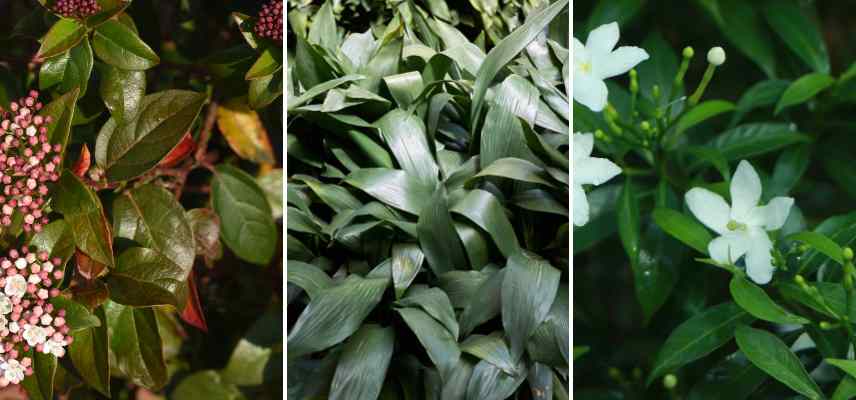
Viburnum tinus, Aspidistra, and common jasmine
Oblong leaves
These leaves are elongated, with nearly parallel sides. Their oblong shape—longer than wide—is a classic among leaves!
Examples: Primula vulgaris, Sophora japonica, Aspidistra (somewhere between elliptical and oblong).
Obovate leaves
These are egg-shaped leaves but inverted, with a narrower base and a broader, generously rounded apex.
Examples: Magnolia, Bergenia, Peperomia obtusifolia.
Lanceolate leaves
Shaped like a spearhead or sword, these pointed leaves add dynamism to the lamina. Their base is slightly wider than the apex. They are found in some bulbous plants, many perennials, and shrubs.
Examples: Olive tree, Eleagnus, Pyracantha, walnut tree, Sansevieria, Yucca, Crocosmia, as well as many ferns like Dryopteris or Matteuccia, which are also described as lanceolate.
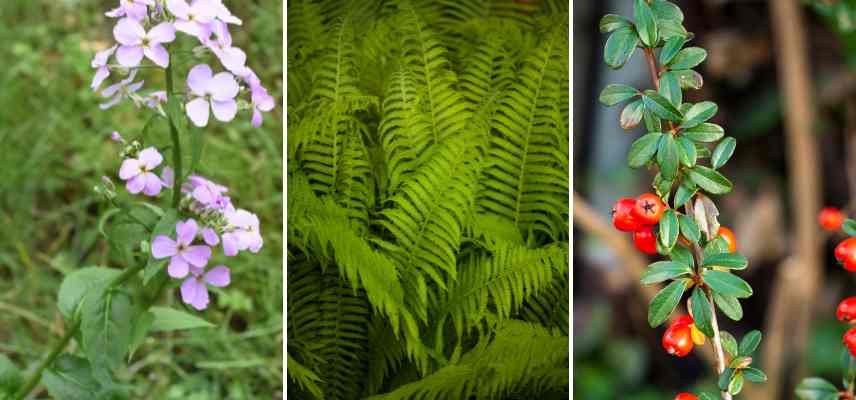
Hesperis matronalis, Dryopteris, and Cotoneaster
Spatulate leaves
Generally elongated and oval, these leaves are rounded at the apex (top of the lamina) and gradually narrow towards the base down to the petiole. They resemble the shape of a spatula (sometimes called spatulate-shaped). This may only be the juvenile form of the leaf.
Examples: Ajuga reptans, Corokia.
The round leaves
These are leaves of a more or less circular shape, which take on specific qualifiers:
Orbicular leaves
This is the botanical term for almost perfectly circular leaves. Their orbicular shape comes from the Latin “orbis,” meaning circle or sphere. These leaves are unique and a model of perfection in the plant world. They are often peltate (peltata), meaning the petiole is attached to the centre beneath the surface of the lamina (rather than at its base, as is the case with most leaves). They sometimes resemble cordate leaves.
Some examples: navelwort (Umbilicus rupestris), Asarum or Pilea.
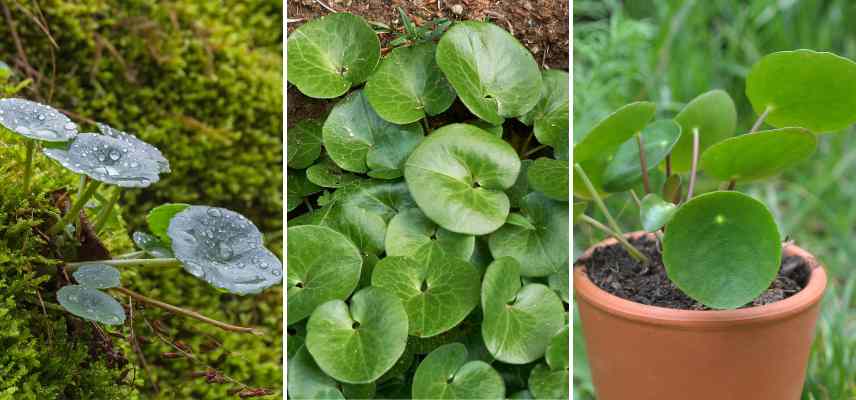
Umbilicus rupestris, Asarum europaeum and Pilea peperomioides
Circular leaves
They are completely round! Like water lilies (Nymphaea), the lotus (Nelumbo nucifera), or garden nasturtium. Their edges are sometimes undulate, as in nasturtium, dentate to crenate in Darmera peltata and Saxifraga stolonifera, or shaped like a pie server in the giant Amazonian water lily.
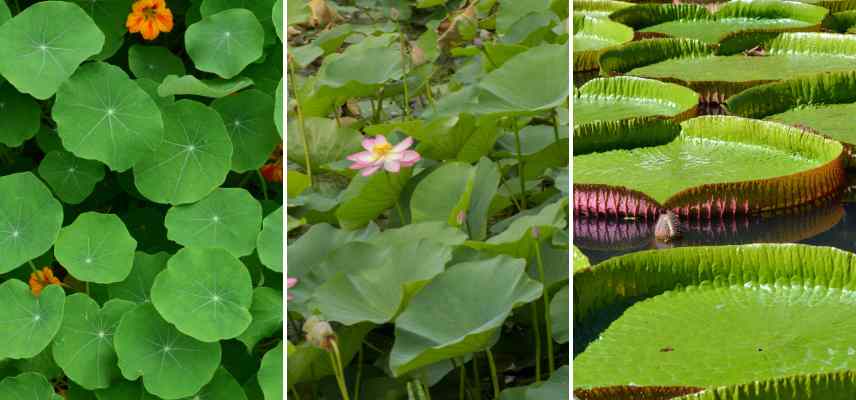
Nasturtium, lotus and Victoria amazonica
Reniform leaves
Literally, kidney-shaped (from the Latin reniformis), these leaves add a touch of originality with their rounded contours and distinctive notch. Their lamina is recognisable by this striking tractor-seat shape.
Examples: Farfugium japonicum, Petasites, and Asarum.
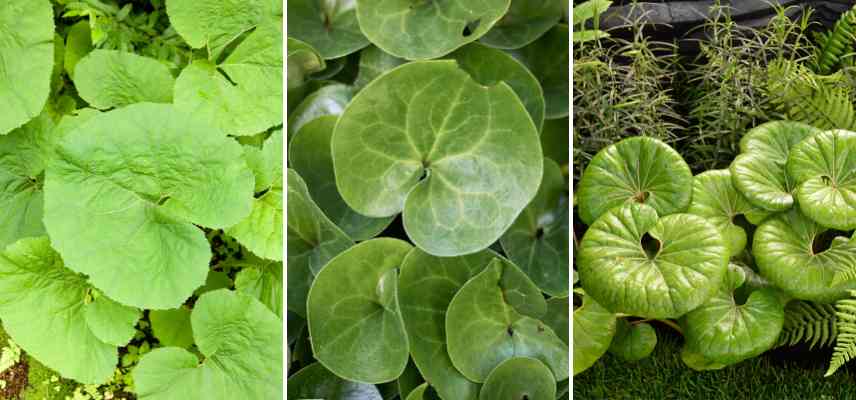
Petasites, Asarum and Farfugium
Heart-shaped or cordate leaves
It is also a subcategory of round leaves, with this small difference that adds to its charm. Here, the base of the leaf is attached in two rounded lobes to the petiole, and the pointed shape at the top of the leaf gives these leaves their name, reminiscent of a heart shape. “Cordata” indeed comes from the Latin “cor, cordis,” meaning heart. This descriptor is found in many species such as Tilia cordata.
A few well-known examples: Cercis sp., Houttuynia cordata, hostas, Colocasia (Taro), some violets, Tilia cordata, Alnus cordata, Cercidiphyllum or katsura tree, morning glory, cup-and-saucer vine, Dicentra better known as bleeding heart, Catalpa, pothos and philodendron (Epipremnum) among houseplants… Note: The lilac leaf has a heart-shaped base but belongs to the ovate leaves, though it tapers to a point.
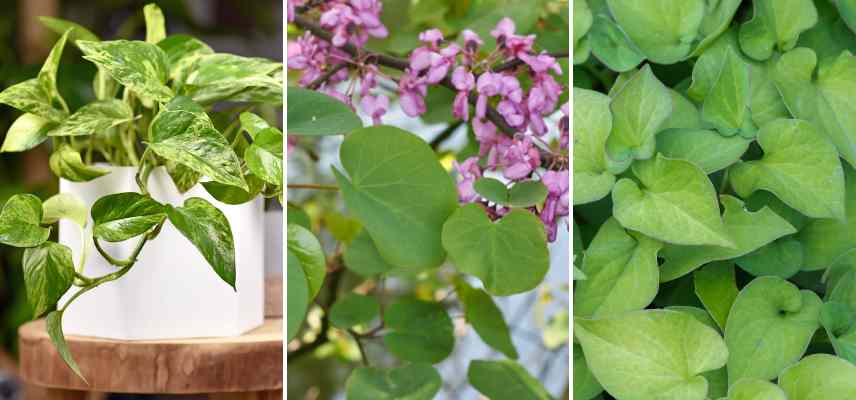
Pothos, eastern redbud (Cercis canadensis) and Houttuynia cordata
The triangular leaves
These leaves are triangular, as their name suggests. They are found mainly in certain poplars and birches and in some ivies (young form of the leaf not yet lobed), but also in the Kalanchoë daigremontiana.
N.B.: so-called cuneate leaves also fall into this triangular leaf category, though they are much less common.
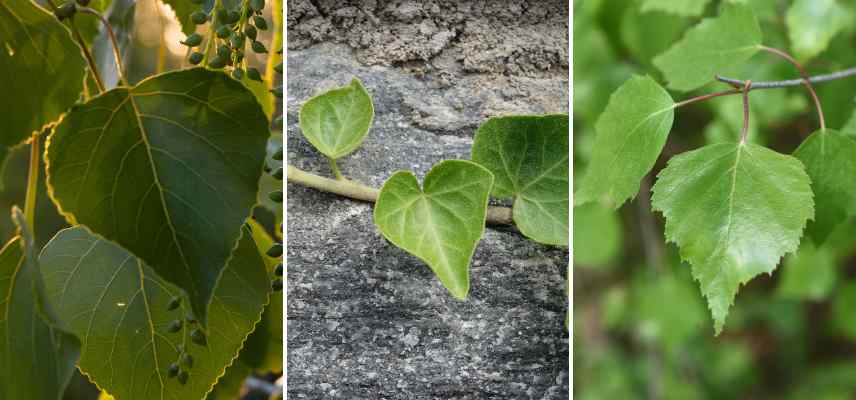
Populus nigra, Hedera and Betula
The narrow leaves and the thin leaves
These are more or less tapered foliages, much longer than they are wide, sometimes with parallel edges, which take on different names:
Subulate leaves (subulata)
These leaves are very narrow and pointed, more or less elongated in the shape of a needle. Their subulate form, from the Latin “subula” meaning needle, is one of many examples of the finesse found in nature. The term subulata is also found in certain species of Phlox, Sagina, etc.
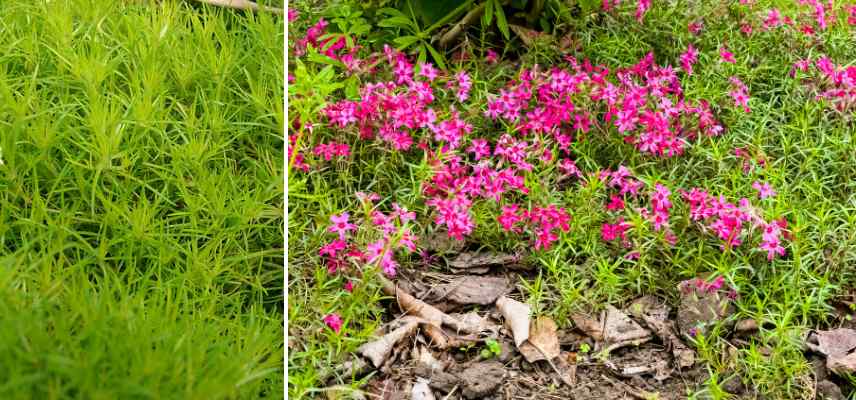
Sagina subulata (©Forest and Kim Starr) and Phlox subulata ‘Atropurpurea’
Linear leaves
They are long and narrow with parallel edges. Their simple and refined shape is a key element of contemporary garden design.
Examples: those of bamboos like Fargesia, Carex (which resemble a gramineous form), Liatris (Kansas feather), or Cordyline.
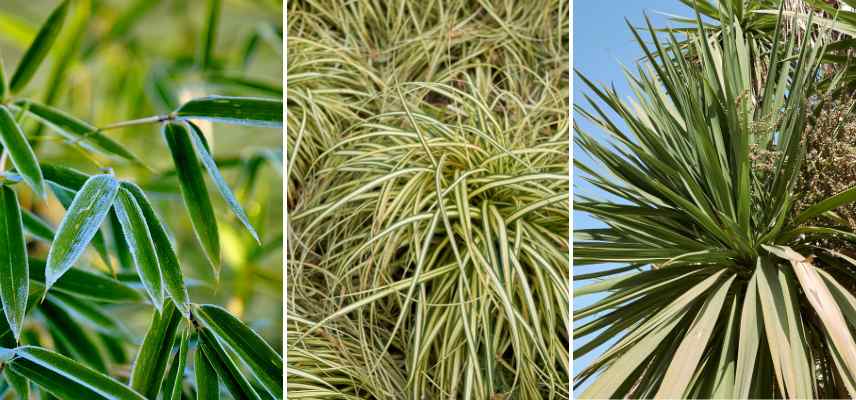
Fargesia nitida, Carex oshimensis, and Cordyline australis
Lanceolate leaves
These leaves are very slender, shaped like a spearhead, and tapered at both ends. They are commonly found in Mediterranean garden species, among plants that have adapted to dry climates by reducing their foliar surface. Many trees or bushes feature leaves that are midway between lanceolate and oblong (like the holm oak).
Some examples: many willows (osier willow, corkscrew willow, weeping willow), olive tree, holm oak, sweet chestnut, as well as persicarias, etc.
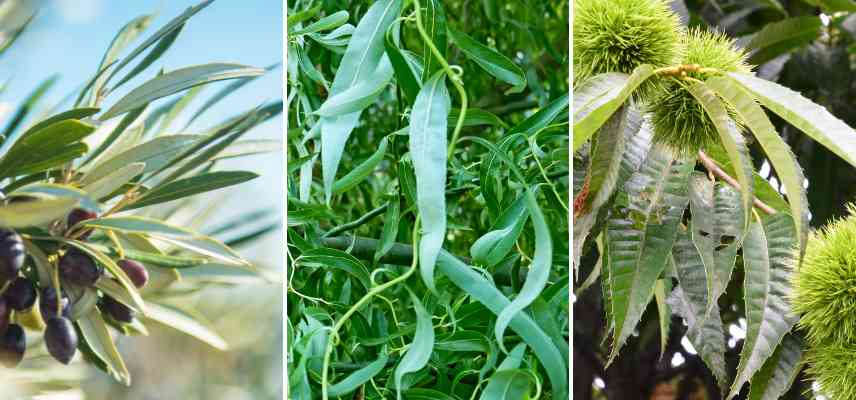
Olive tree, corkscrew willow, and sweet chestnut
Ribbon-like leaves
The lamina here is ribbon-shaped, long and flat, sometimes very flexible. These are the typical leaves of Clivia, Agapanthus, certain Iris, etc. They are commonly referred to as sword-shaped or ensate leaves in Iris or Crocosmia, also resembling lanceolate leaves.
Acidular leaves
Needle-shaped and rigid, these leaves are typical of conifers. Their name, derived from the Latin “acus” meaning needle, reflects their slender form ending in a point.
Examples: Pinus sp., Picea sp., Juniper, Larch, etc.
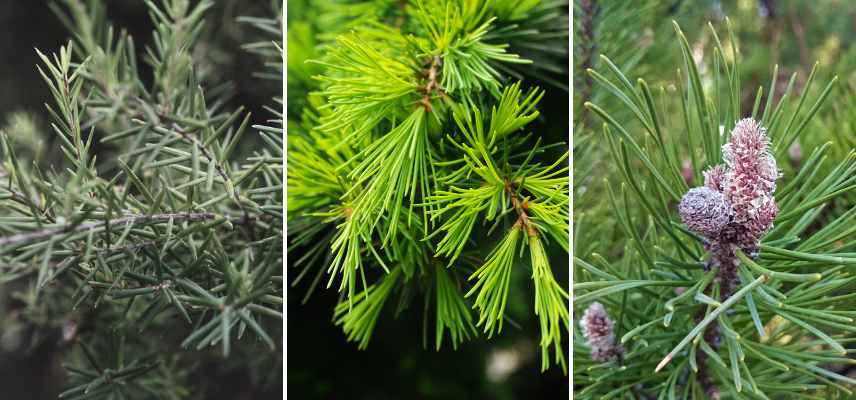
Juniperus, Cedrus deodora, and Pinus sylvestris
The palmate leaves
Palmatilobate and Palmatilobate Leaves
These leaves are a subcategory of lobed leaves that I won’t cover in full here due to their complexity. With lobes or segments radiating from a central point, featuring palmate nervature, they resemble the shape of an open hand. The lobes extend beyond halfway into the leaf. They are both pinnate and lobed. There can be 3 to 5 main lobes, sometimes up to ten, and occasionally many more in palmate-fronded palms. Their name derives from the Latin “palma” meaning palm. We speak of digitate leaves when the leaf resembles fingers formed by five lobes.
Some nuances exist in so-called palmatifid leaves like those of Tetrapanax: the divisions are less deep, reaching only halfway into the leaf.
Examples: maples (Acer sp.), Liquidambar, plane tree, Hepatica (perennial), Fatsia japonica, Schefflera taiwaniana, heucheras, but also Aconitum napellus whose lobes are particularly deep and narrow like those of some Japanese maples.
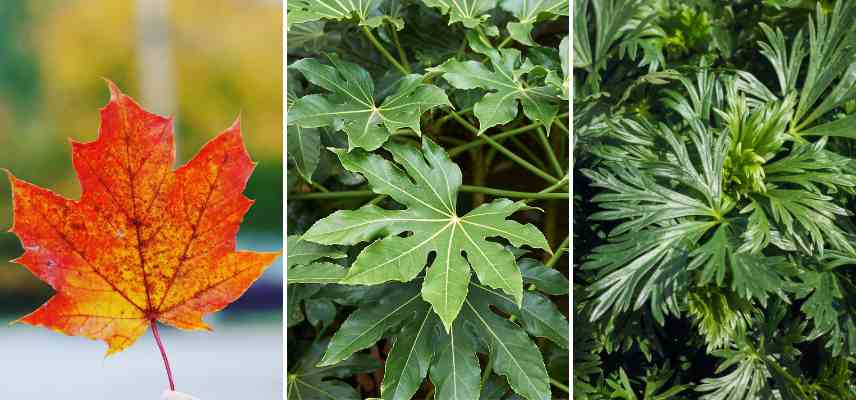
Maple, Fatsia japonica and Aconitum napellus
The original leaves
They are less common, yet distinctive and unusual, sometimes even the sole representatives of a genus or species!
— **Fan-shaped or flabellate leaves**: As seen in the unique foliage of the Ginkgo.
— **Truncate leaves**, like the singular leaf of the Liriodendron (tulip tree), also described as quadrilobate.
— **Rhomboid leaves**, from the Greek *rhombos* meaning spinning top, are diamond-shaped. They are also referred to as rhombic leaves, such as those of the [Italian poplar](https://en.promessedefleurs.eu/shrubs/shrubs-by-variety/populus-poplar/populus-nigra-italica-black-poplar.html).
— **Sagittate leaves**: The lamina takes the shape of an arrowhead in certain tropical or aquatic plants, including Taro (*Alocasia*), arrowhead ([*Sagittaria sagittifolia*](https://en.promessedefleurs.eu/perennials/aquatic-plants/aquatic-perennials/sagittaria-sagittifolia.html)), *Xanthosoma sagittifolium*, Caladium, or *Arum italicum*.
— **Hastate leaves**: Similar to sagittate leaves but typically defined as resembling halberd blades. The term *hastata* appears in several species, such as the [hastate willow (*Salix hastata*)](https://en.promessedefleurs.eu/shrubs/shrubs-by-variety/willow-salix/salix-hastata-wehrhahnii-willow.html) or [blue vervain (*Verbena hastata*)](https://en.promessedefleurs.eu/perennials/perennials-by-variety/verbena-vervain/verbena-hastata.html).
Not to mention perforated leaves like those of *Monstera deliciosa*, though this term is not exclusive to botany.
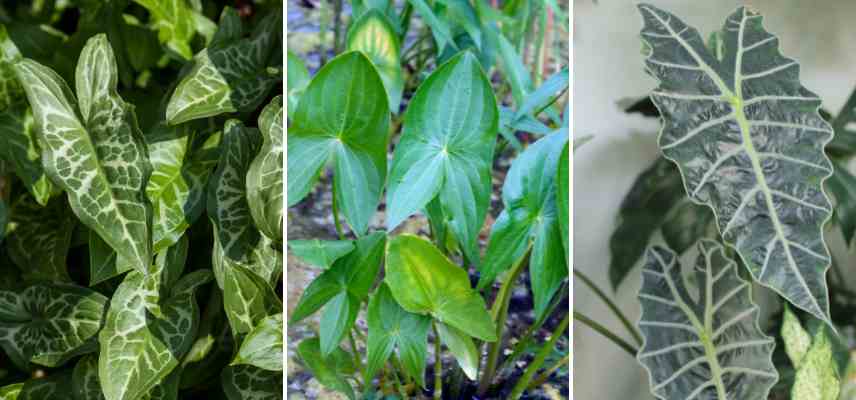
*Arum italicum*, *Sagittaria sagittifolia*, and *Alocasia*
- Subscribe!
- Contents































Comments